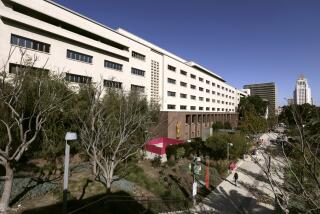Funds Allotted for New Courthouse
- Share via
SANTA ANA — Long-stalled plans to build a new South County courthouse got an unexpected jump-start when the Board of Supervisors voted Wednesday to allocate $5 million--$3 million from the Merrill Lynch settlement--for it.
The action marks the first time that money has actually been set aside for the proposed courthouse and comes as the county is exploring sites in Rancho Santa Margarita and the Ladera planned community.
The new courthouse would replace two overcrowded courts in Laguna Niguel, where judges handle more cases per capita than any other municipal court in the state. Officials have long complained that the cramped conditions make it difficult for them to assemble jurors and store paperwork.
“I’ve been waiting for this moment for 14 years,” said Municipal Judge Pamela L. Iles, a longtime booster for a new building. “I’m ecstatic that we are finally moving forward with this.”
Construction of the new courthouse is expected to cost about $52 million. But Supervisor Thomas W. Wilson said the county is examining various methods for financing the project, including issuing bonds once Orange County’s bankruptcy-battered credit rating improves.
“This is a very important step because it’s the first time the county has actually earmarked funds for the courthouse,” Wilson said. “It shows the board’s commitment.”
Supervisor Todd Spitzer, who along with Wilson has been looking for courthouse sites, agreed. “If we waited and didn’t act today, I think some other project would come along and we might never get funding for the South County courthouse,” Spitzer said. “We’ve already seen so many delays.”
The board approved the courthouse funding one day after it reached an agreement with the cities and schools that also lost money in the financial debacle. The agreement called for them to receive $27 million of the $30 million that Merrill Lynch & Co. paid to avoid possible criminal prosecution for its role in Orange County’s 1994 bankruptcy.
The cities and schools also received $11 million in leftover bond repayment funds.
The county received the remaining $3 million of the Merrill payment, plus $10.3 million in previously undistributed interest from various accounts in Orange County’s investment pool.
Supervisors heatedly debated what to do with the $13.3-million windfall, as well as another $8 million in discretionary money they have yet to earmark.
The board eventually voted 4 to 1 to allocate $5 million for the courthouse and to decide how to use the rest in October, after County Chief Executive Officer Jan Mittermeier prepares a report on the subject.
Supervisor Jim Silva was the lone “no” vote.
Earlier, Silva and Spitzer tried unsuccessfully to transfer at least $10 million into the county’s special account for repaying its bankruptcy debt early. Spitzer proposed pulling out $5 million for the South County courthouse, but the other three supervisors rejected the motion.
What resulted was an hourlong discussion highlighting the board’s philosophical split over government spending.
“The rest of the board said bond defeasance was a high priority, and yet, that slid out the window when push came to shove,” Silva said. “That’s one of the reasons the county got into its [financial] troubles in the first place.”
The cost of servicing the county’s bond indebtedness this fiscal year--including bankruptcy and capital improvement bonds--is $1.04 billion, or 28% of the total county budget.
Supervisors set a goal of putting aside $140 million for early debt repayment; of that, about $50.3 million has been set aside, including $24 million from the current budget.
Board Chairman William G. Steiner said the county has tremendous pent-up demand for things such as addressing deferred maintenance on county buildings and solving the problem of overcrowding at its jail and juvenile facilities. To move all its extra money to an early bond repayment account would eliminate flexibility to use money where it is most needed, he said.
However, Steiner said after the meeting that he would join Silva and Spitzer in earmarking about $111 million for early bond repayment when it becomes available in one or two years.
The $111 million is in a fund created from borrowed money after the bankruptcy for short-term needs of county departments.
Before the bankruptcy, the county borrowed money from lenders backed by anticipated property taxes and other revenue. After the bankruptcy, the interest rates on that kind of outside borrowing became too expensive.
The county now expects it will be able to get outside short-term financing with reasonable terms in one or two years, freeing up the $111 million.
More to Read
Sign up for Essential California
The most important California stories and recommendations in your inbox every morning.
You may occasionally receive promotional content from the Los Angeles Times.











